Despite rapid advances in technology, the physical event badge remains one of the most important elements of in-person event experiences. Why? Because badges still serve as a multifunctional tool for identification, access, branding, and - perhaps most critically - human connection, resulting in business relationships being made and maintained at events. In this insight-packed report, we will explore event badges and their exciting future.
Introduction: Who was interviewed and why event badges matter in 2025
This report is based on in-depth interviews with event industry leaders, each bringing their own perspective on badge design, technology, and attendee experience. Their contributions offer practical insight and forward-thinking ideas that helped shape this guide:
- Claus Raasted – Former Senior Advisor at McKinsey. A veteran in immersive event design and innovation.
- Emily Miller – Director of Marketing at Founders Forum Group. Specialises in curating high-impact, high-touch events for global leaders in tech, business, and policy.
- Elijah Clark-Ginsberg – Event Strategist at BetterUp. Known for championing inclusive, scalable event design rooted in real user needs.
- Andy Barr – Founder and Event Technology Consultant at Event Connections. Expert in registration solutions & badge printing for events of all shapes and sizes.
- Tim Groot – CEO and Founder of Grip. Leads the industry’s leading AI-powered event platforms, which is built for engagement.
- Elad Rosanski - Co-Founder and CEO at Xtag. Rosanski is an experienced entrepreneur who co-founded Xtag, an event check-in and badge printing company.
- Oliver Smart - SVP of Onsite at Grip. Over seven years’ event industry experience, formally MD at Jonas Event Technology, the registration services company.
Attendees wear event badges around their necks for hours. Exhibitors use them to quickly qualify leads. Sponsors see them as walking brand real estate. And organizers rely on them to manage logistics and monitor traffic.
“Badges are amazing real-estate,” explains Elad Rosanski, an entrepreneur who runs Xtag, an event check-in and badge printing company. “Often they’re the number one sponsorship opportunity, companies literally fight over it! This is because it’s so valuable to participants. It’s their access to the show and sessions, plus it features valuable information, like access to the agenda, event app and enables connections.”
“We're stuck in a rut, churning out badges that look like they're from the 1950s.” – Claus Raasted
Yet, despite this centrality, badge design has been largely stagnant.
“We're stuck in a rut, churning out badges that look like they're from the 1950s,” says Claus Raasted, an event designer and author who has long called for greater intentionality in badge design. Raasted argues that the industry is hamstrung by legacy thinking, with oversized logos and tiny fonts dominating real estate that could otherwise spark genuine human interaction.
Today, forward-thinking event professionals are beginning to question every part of the badge experience. From the materials used to the fonts chosen, the badge is being reimagined as a strategic touchpoint with enormous potential. This report explores what the future holds, using insights from leading experts and drawing from real-world examples of innovation.
1: Purpose-driven event badge design
The most effective event badges are not designed at random. Instead, they start with a fundamental question: What is the primary goal of this badge?
Is the badge a tool for sparking networking? A branded souvenir? A method of verifying access to different sessions? A lead capture device? Many event organizers try to make the badge do all of these things at once, resulting in cluttered, confusing, and ineffective design.
“Many badges are simply afterthoughts, lacking a clear purpose,” says Raasted. “We're stuck with designs that prioritise brand over utility. The oversized logo dominates, but the name, the bit that facilitates connection, is sometimes rendered in minuscule font.”
“Ask yourself: what do you want the badge to do? Facilitate conversations? Enhance branding? Control access? Design it for that.” – Claus Raasted
For Raasted, good design starts with intent. If you want attendees to network, then prioritise names and icebreakers. At a recent experience summit, Raasted praised badges that included lines like “Ask me about sustainable event practices” or “I’m looking for a mentor in the tech industry” - hooks that encouraged spontaneous conversations. Other additions to the badge could include statements, special interests, industry focus indicators, participant type or even social media handles to boost online engagement.
“Imagine badges that say 'Ask me about sustainable event practices.' That's a conversation starter.” – Claus Raasted
“For me, the key badge design aim is to boost ‘speed to lead’”, explains Oliver Smart, Grips onsite services leader. “Lead capture at B2B events is often the reason why most participants are there so we must orientate badge design around that.” For example, Smart says you should highlight the industry and whether a participant is an exhibitor on the badge itself. “This results in exhibitors avoiding spending too much time on people who aren’t relevant to you, like fellow exhibitors. In addition, organizers should design their badges so participants can be scanned as quickly and easily as possible to maximize lead capture.”
This point is backed up by Rosanski who believes in event efficiency: “Time spent at the event is the most important element. Badges allow us to optimize for that. This can be as simple as having three different event badge types that are clearly labelled: attendee, visitor and VIP.”
2: Event badge types and best practices by attendee role
Badges serve different purposes for different stakeholders, and a one-size-fits-all approach rarely delivers. Emily Miller, who leads marketing at Founders Forum Group, illustrates this with their use of colour-coded badges.
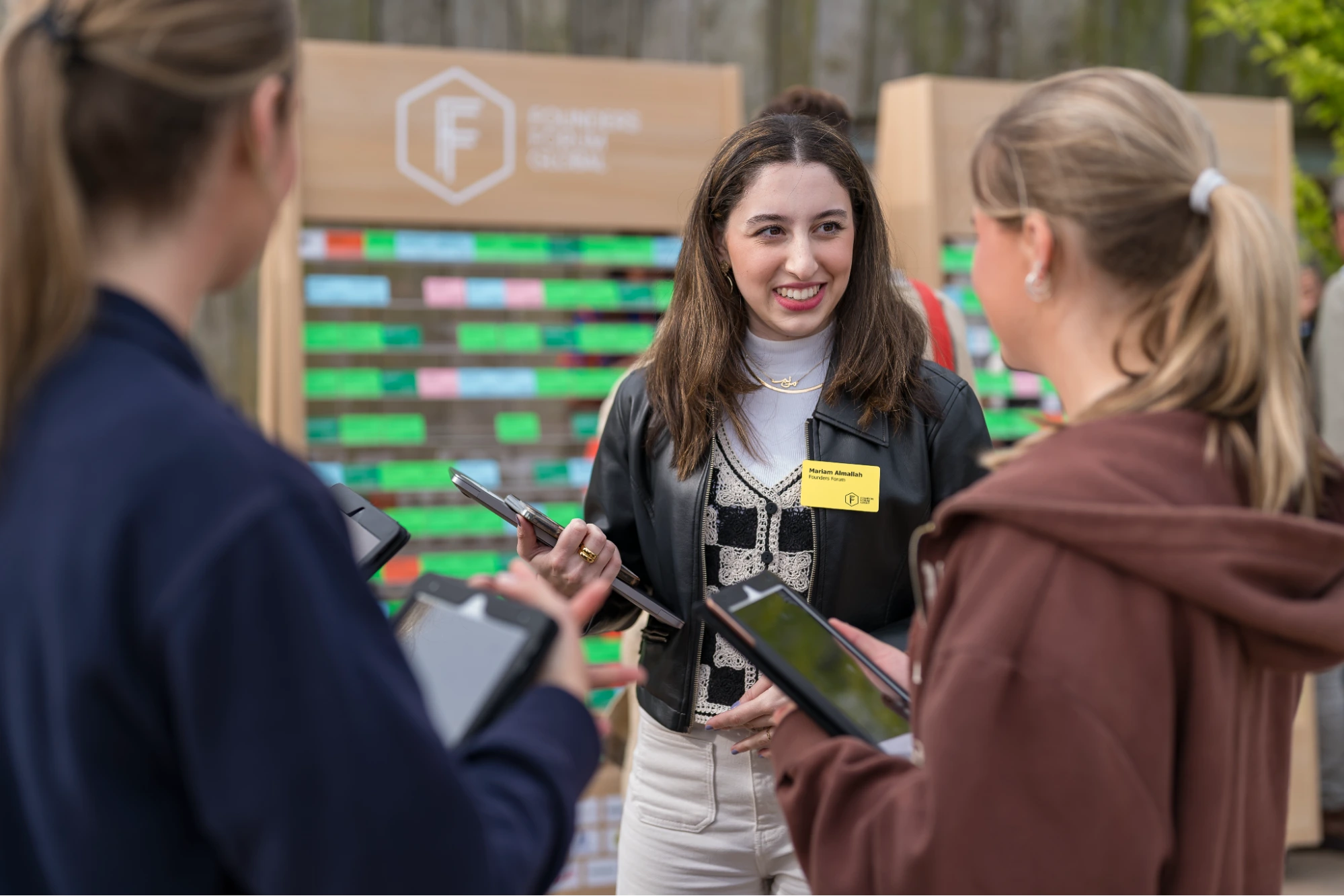
Initially implemented to help attendees identify journalists at a glance, the system expanded to cover founders, investors, team members, and partners.
“It helps attendees quickly identify potential connections,” says Miller. “At our events, there are no pre-scheduled meetings. We rely on curated serendipity, and the badge colours play a critical role in facilitating that.”
“Our badges also track people’s locations throughout the event so guests can easily find one another via our event app.” – Emily Miller
Best badge practices for event attendees
According to Elijah Clark-Ginsberg, a pragmatic overseer of badge design at BetterUp’s events, the focus should be on readability and inclusivity. “Keep it simple. Large, readable first names, and a design that doesn’t overwhelm. Less is more.” He also champions sticker sheets that allow attendees to self-identify, whether that’s through pronouns, interests, or goals.
“Offer personalization options, it adds a fun touch and empowers attendees to self-identify.” – Elijah Clark-Ginsberg
Another benefit of badge design is to use it as a way to ensure your participants download the event app so they get the most out of the show. A good way to prompt this is by ensuring event badges have a call-to-action printed on them e.g. “Download the app” with a QR code to your app landing page.
Free event badge design template library
To help with badge design, Grip has created a range of templates for you to use for free. There are over 50 different badge designs, using the latest trends. Also included is a helpful list of ‘Dos and don'ts’. To access the badge design template library in Figma, simply click here.
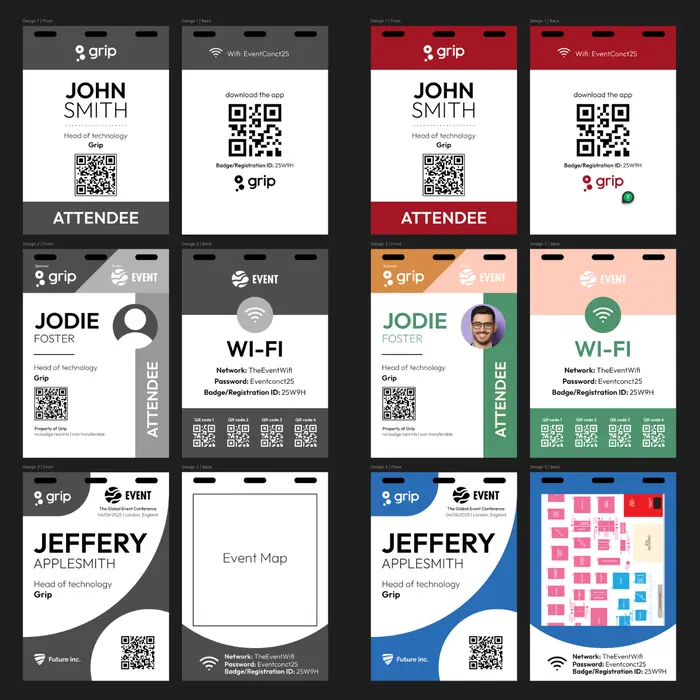
Badge functionality for exhibitors and sponsors
Participant badges need to do more than identify, they often serve as scanning devices. QR codes are standard, and increasingly, event apps allow for instant lead capture. Sponsors often seek prominence, but smart placement, such as branding on the reverse or lanyards, ensures their visibility without interfering with attendee identity.
Smart badge data for event organizers
Smart Badges badges offer real-time data, including session attendance and crowd heatmaps. Founders Forum uses smart badges to display live location data on-screen, aiding both attendees and organizers. “You can search for someone in the app, see where they are, and find them instantly,” says Miller. For more on Smart Badges, the following section will provide a deep dive on the technology.
3: Future event badge technology trends and innovations
There are a number of innovations going into event badges, such as bluetooth, e-ink and even badges that come as wristbands.
Smart badges
For example, Grip is helping redefine what badges can provide with its new electronic Smart Badge product. These bluetooth-enabled devices allow participants to exchange contact details with a simple tap, eliminating the need to scan a QR code or use an app. By embedding seamless connectivity into the badge itself, Smart Badge-enabled events see a tenfold increase in participant connections.
“Initially I was skeptical of Smart Badges,” reveals Smart. “But having click-to-connect functionality is a gamechanger because it’s another way to improve ‘speed to lead’. Anything we can do to increase the number of leads generated at events is a win for organizers and their customers.”
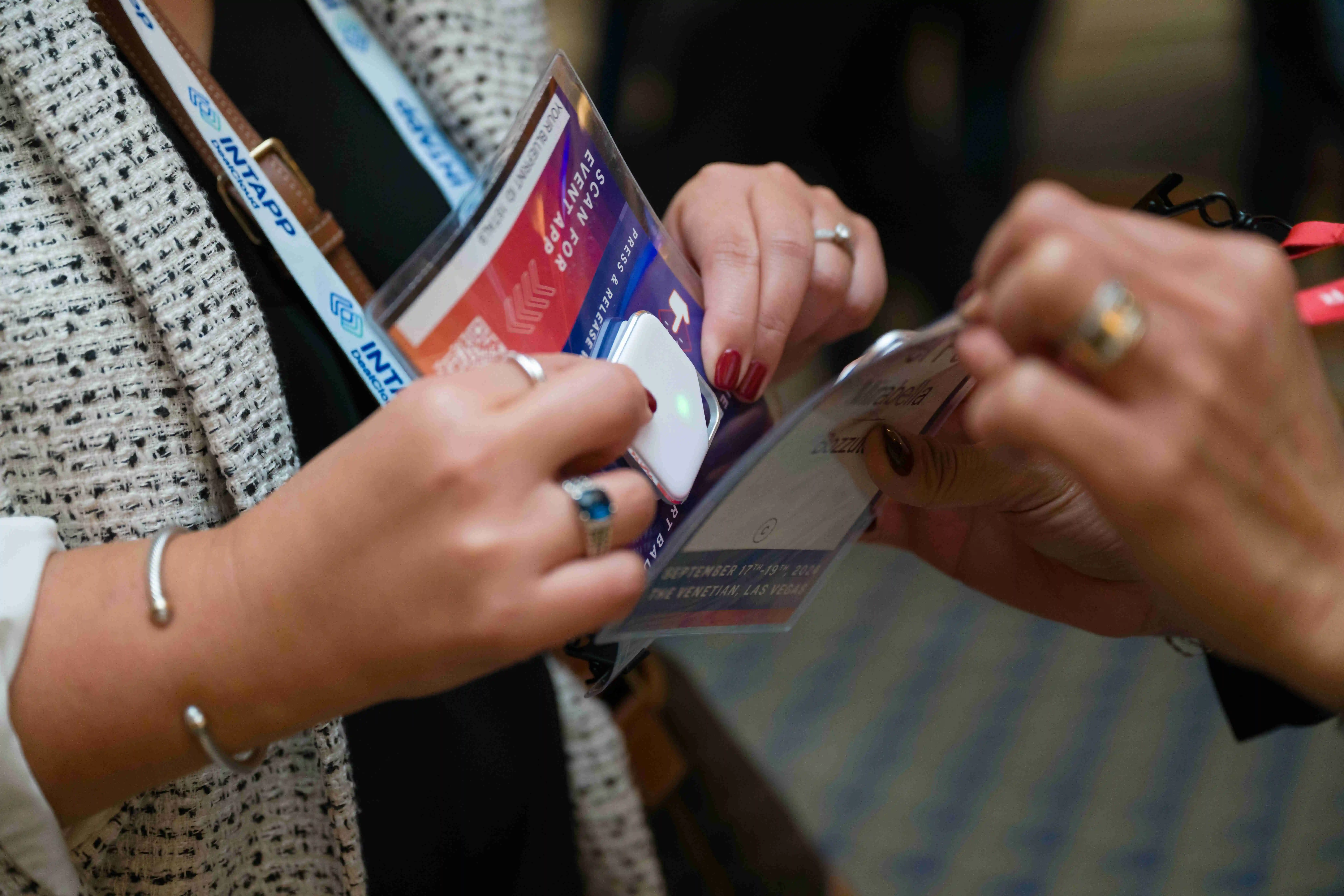
Smart heatmaps
The hardware’s functionality doesn’t stop at networking. Smart Badges can track session attendance in real time and generate heat maps showing where meaningful interactions are taking place on the show floor. This has dual benefits: organizers can refine the event layout to promote better flow, and sponsors can gain insight into attendee behaviour and session popularity. This is all data that can support exhibitor ROI discussions, content planning and sponsorship renewals.

Moreover, Oliver Smart believes that the existence of something physical for participants to interact with has physiological benefits. “Research has shown that people prize physical goods over digital. So the act of giving out Smart Badges for exhibitors to collect leads enhances the perceived value your show provides.”
How it works
At registration, participants' Smart Badges are paired with their app-enabled event profile. From there, connections are registered automatically when two attendees want to connect. All they need to do is each press the Smart Badge button when they are near, a green light flashes and contact details are exchanged in real-time, ready to be downloaded at a later date.
Founders Forum has been ahead of the curve with this technology. "For several years now we’ve been using a custom version of our lapel badges that are tracked live onsite, said Emily Miller. "It’s a custom form factor that works really well for us. The badge tracks guests’ locations throughout the event, enabling us to show who is inside each room at any given point. This makes it easy to see who’s present in a particular session, and for guests to check not only who’s speaking on a stage but who is there listening. We also use the location tracking for heat mapping in our post-event analysis. The most unique feature is probably that you can see everyone’s location in our event app, so if you’re looking to meet someone specific, you can simply search for them in the app, see where they are and find them. This would probably work differently in a larger tradeshow context but for our smaller, curated community, it’s a great way to help people find each other."
While technology, like Smart Badges are reshaping the product category, not all innovations are driving change. Andy Barr of Event Connections notes that while printers and scanners are improving, badge tech often lags behind due to a reliance on off-the-shelf hardware. “We’re often adapting existing technologies rather than driving true innovation,” he explains.
E-Ink and more
Smart wearables and e-ink displays are on the horizon, offering dynamic updates and enhanced personalization.
“E-ink name badges that adapt in real-time are the future. But we’re not there yet.” – Andy Barr
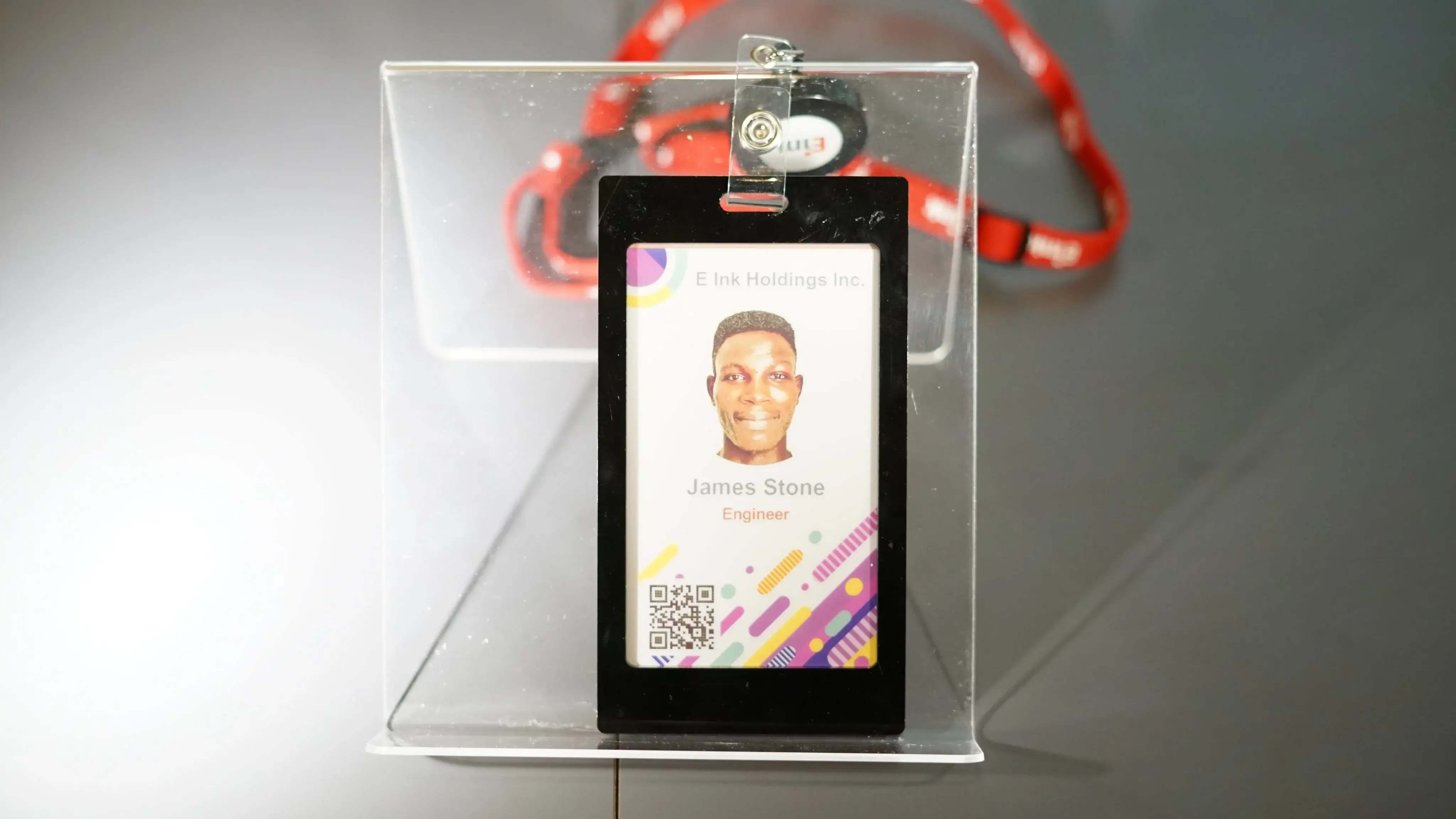
“E-ink badges are interesting if you want sustainability, auto-updates, push notifications and a place to display the agenda”, said Smart. Yet cost remains a barrier. Clark-Ginsberg advocates for cost-effective alternatives: “QR codes do 90% of what NFC does, and at a fraction of the price.”
“Think wristbands that subtly vibrate to remind you of meetings or let you know when you’re near someone you’ve expressed interest in via the event app. These technologies offer a more seamless and personalised event experience.” – Emily Miller
As attendee familiarity with QR codes increases post-pandemic, expect dual-function codes, used both for access control and peer-to-peer networking, to become standard.
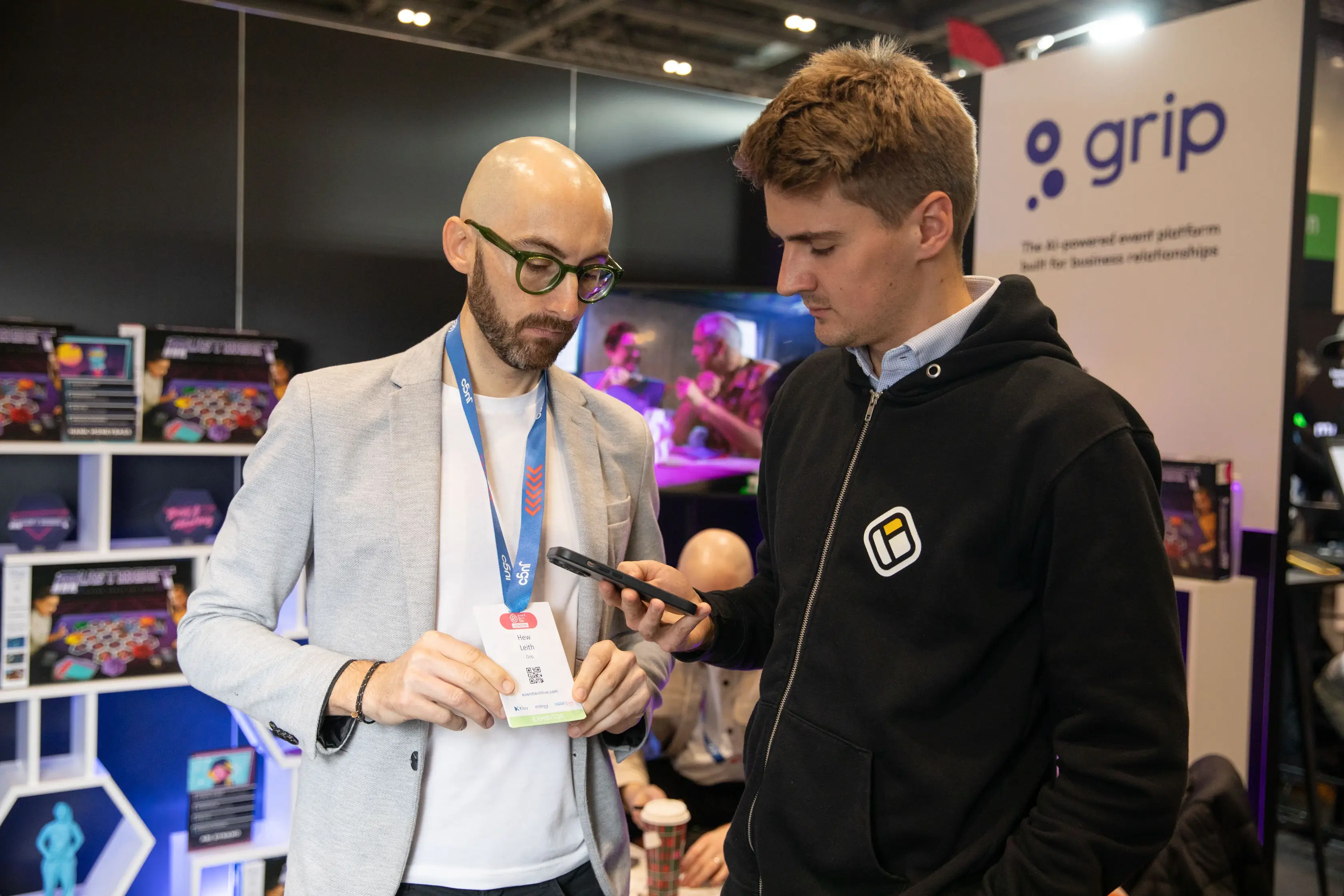
Integrations
Finally, it’s easy to overlook the less sexy side of badge technology. According to Rosanski, software integrations with different technology platforms are driving event badge efficiencies. “The technological driver for badges right now is integrations. Organizers want to avoid relying on Excel and connect all their tools seamlessly so they can create their badges quickly and easily.”
4: Designing badges for real people: Sustainability and inclusive badge design for all attendee needs
There are a number of practical considerations when it comes to badge design. The following can significantly improve the attendee experience:
- Sustainability: Consider sustainable badge and lanyard options like rPET lanyards made from recycled bottles, bamboo or seed paper badges, and reusable plastic or wooden badge holders. Explore durable, eco-friendly materials such as laminated paper for badges and lanyards, as recommended by Elijah Clark-Ginsberg. These materials can be both cost-effective and visually appealing while reducing waste.
- Lanyard length: Shorter lanyards allow for easier name recognition and maintain natural eye contact. Both Claus Raasted and Elijah Clark-Ginsberg advocate for offering lanyards in multiple lengths to accommodate attendee height and preference. Clark-Ginsberg goes one step further: “Adjustable-length lanyards are definitely a nice-to-have in my book.”
- Double clip lanyards: A simple yet effective adjustment. Elijah Clark-Ginsberg recommends using double clip lanyards to prevent badges from flipping and to ensure consistent visibility of key information throughout the event. As he puts it: “Double clip lanyards – non-negotiable.”
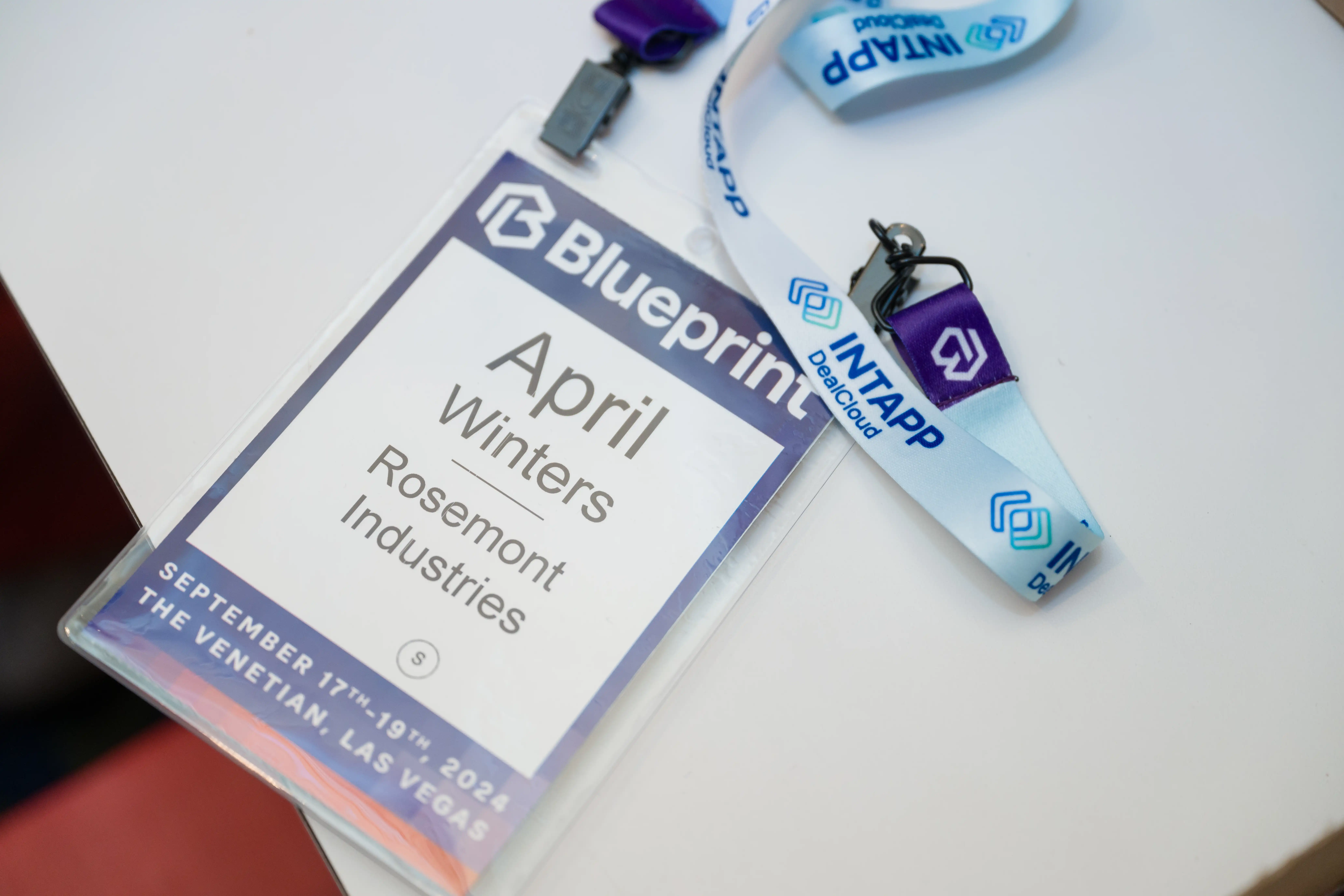
“More Xtag clients are asking us for sustainable badges,” revealed Rosanski. “It’s all about balance. You can’t avoid impact on the environment but you can minimize it. For example, you can use badge material that can be recycled. Even if you don’t think your badges can’t be recycled, you can often find a supplier, like TerraCycle, that can recycle almost anything. This trend in badge sustainability will only increase over time so it’s important to take it seriously now.”
Inclusive badge design is also an important consideration. As such, it is no longer a luxury: it's a necessity. Drawing from principles of inclusive design, it's essential to consider diverse user needs from the outset. This involves engaging with users, understanding their context, and creating solutions that accommodate a wide range of abilities and preferences.
Badges should feature large, legible fonts and high-contrast colors to aid those with visual impairments. As Claus Raasted notes: "Clear and concise information is needed on badges. Prioritize large font sizes for names and relevant details to facilitate effortless readability."
Providing options for pronoun stickers or customizable fields fosters a sense of belonging among attendees. Offering various attachment methods, such as clips, magnets, or lanyards, ensures comfort and accessibility for all users.
Adopting a participatory design approach, where feedback from diverse user groups is actively sought and incorporated, can lead to more effective and inclusive badge designs. As Emily Miller notes, “Accessibility is paramount. We need customisable experiences that cater to everyone.”
“Events can still be so inaccessible but AI opens the door for ultra-customisable and personalised experiences that enable everyone to derive maximum value from their attendance.” – Emily Miller
Clark-Ginsberg agrees, pointing out that clip options and large fonts aren’t luxuries: they’re essentials. His design checklist includes: double-clip lanyards, pronoun sticker sheets, and minimal clutter. “No one wants a flipped badge or a 30-word job title crammed into six-point font,” he quips. He also explains his approach to the most underused part of the badge, the back! "The back of the badge is perfect for essential event information: Wi-Fi details, agenda snippets, or venue maps. Keep it consistent and helpful," explained Clark-Ginsberg.
5: Event badge cost breakdown and pricing trends
The future of the badge is intrinsically tied to the cost of producing one. A wide range of variables, from badge type and print method to venue location and event scale, can significantly influence the final cost per badge.
To better understand this complexity, we’ve created a matrix that outlines how the distribution of badge-related costs shifts depending on the size of the event. The matrix also includes a projection of how each cost category is expected to evolve over the next five years.

Software
Badge printing software is often seen as a minor cost, but its complexity increases dramatically at larger events. Local networks, multiple entrances, and more advanced requirements mean the software must be robust and reliable. While software costs don’t scale with attendee numbers, and may even decline due to AI and automation, the rising expectations around features and integrations could offset any reductions, keeping software spend stable.
Andy Barr breaks the cost of badging down into five categories: software, people, logistics, hardware, and consumables. “The price of the badge is just one part of the process,” he cautions. “Logistics and labor often eclipse the cost of the materials themselves.”
People
Post-pandemic, personnel costs - especially for technical staff handling onsite badge setup - have surged. Skilled freelance operators are becoming harder to find, and their services are increasingly expensive. For small events, this category often represents the largest proportion of the total cost. In cities with a high density of events and lower wage expectations, this burden may be somewhat alleviated.
Logistics
Shipping badge-related hardware such as printers and tablets can be surprisingly expensive, particularly for smaller events. The cost does not scale neatly; transporting one printer versus ten might incur similar vehicle costs. As fuel prices climb and sustainable logistics become a higher priority, we expect this category to increase steadily.
Hardware
As Andy Barr notes, the market for badge-specific hardware is small, which means most providers rely on general-purpose printers. This limits innovation and drives up costs. Globally, printer use is declining, making suitable devices more expensive. Meanwhile, tablets, being widely adopted, are dropping in price, creating a divergence in hardware cost trends.
Consumables
This is the cost category most directly tied to attendee numbers. For smaller events, it remains a modest portion of overall spend. But at scale, the cost of badges, lanyards, and holders adds up fast. Sustainability pressures are also driving up prices, with more recyclable and single-material options entering the market.
Producing badges is no longer just a printing exercise, it’s a multi-layered operation. The table below shows the percentage of costs associated with each category depending on the size of the event. For smaller events, you’ll notice that categories you might expect to be minor, such as people and logistics, actually form the bulk of the cost. In contrast, for larger events, these categories scale more gradually, and line items like software and hardware become more cost-efficient on a per-attendee basis.
Groot notes that logistics costs can be surprisingly high. “Shipping equipment across borders, or even just across a city, adds up quickly,” he says. “And yet it’s often overlooked in budgeting.”
The future for badge costs
The bottom line for Rosanski is badge costs are going to see an increase. “I don’t see badge costs going lower any time soon. With tariffs and inflation, they’re only going to increase in the short to medium term.”
6: Optimising badge collection and onsite check-in experience
The badge pickup experience is a moment of truth for many attendees. “We wanted to move away from the typical 'cookie cutter' registration experience,” says Emily Miller. “Instead, we created a self-serve badge wall with staff assisting attendees in finding their badges on large boards. It creates a welcoming, peer-to-peer atmosphere that prevents queuing and provides guests a positive first impression of the event.”
.webp)
“We wanted to move away from the typical 'cookie cutter' registration experience.” – Emily Miller
Innovations in this area focus on both efficiency and personalization. Self-service kiosks equipped with intuitive interfaces allow attendees to check in and print badges swiftly, reducing wait times and crowding. Mobile pre-registration and QR code scanning can further streamline the process, enabling attendees to bypass traditional check-in lines.
“We will see more self-service kiosks in the future, explained Rosanski. “Combine kiosks in the venue with QR codes on people’s phones and we’ll see more participants entering shows as fast as possible, a win for everyone.”
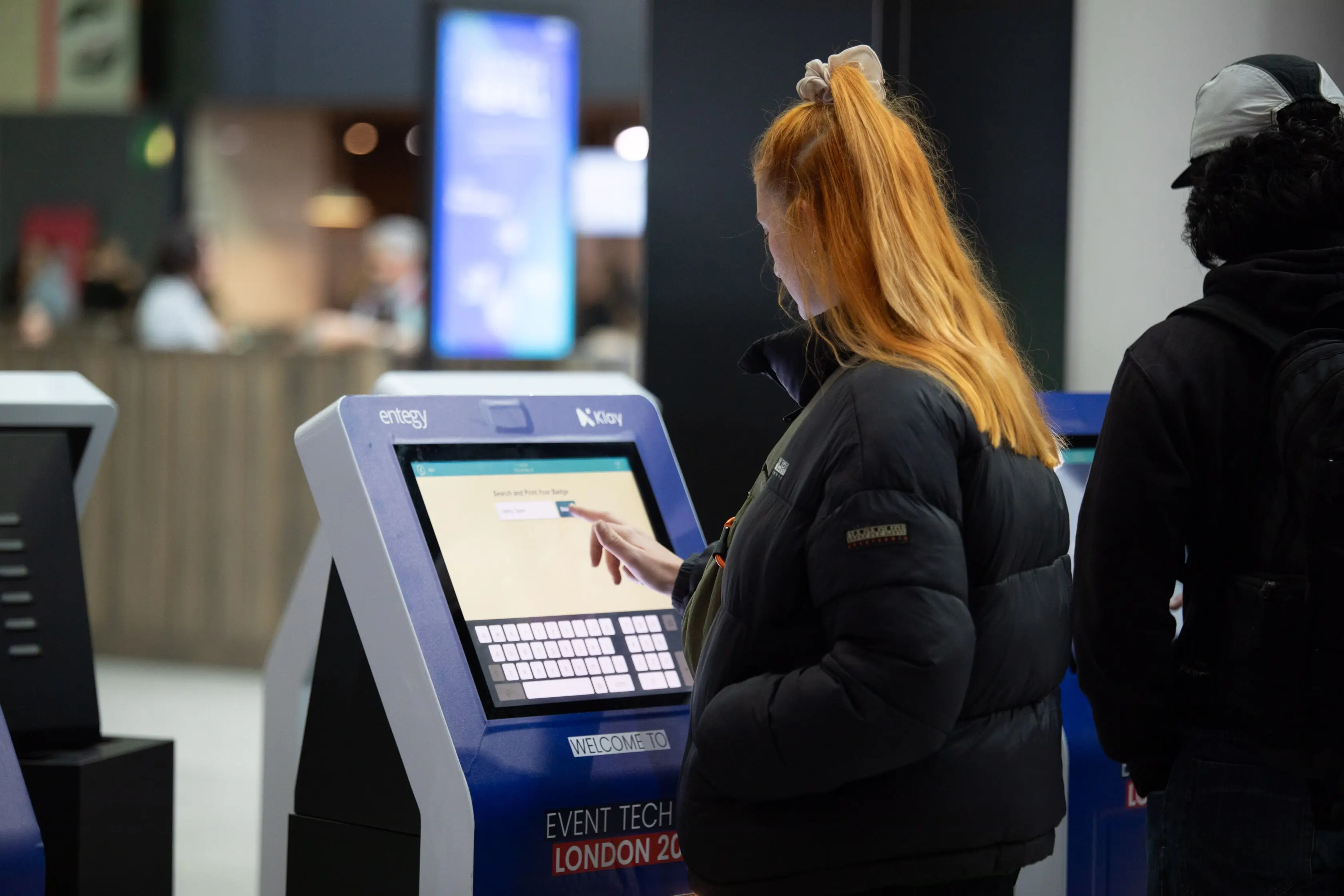
Some events have introduced RFID-enabled badges that automatically check in attendees upon entry, enhancing both convenience and data collection. Personal touches, such as welcome messages or customized badge designs based on attendee profiles, can enhance the overall experience and foster a sense of connection from the outset.
Clark-Ginsberg promotes serpentine queues and “I’m free” paddles for staff as smart, low-tech ways to improve flow. Meanwhile, hybrid badge strategies such as pre-printed colour badges with on-site black and white stickers offer a balance of quality, speed and cost-effectiveness.
7: Common event badge design mistakes to avoid
Common pitfalls in badge design can hinder attendee interaction and event flow. One frequent issue is cluttered layouts that prioritize branding over essential information like attendee names and affiliations. Again, see Grip's badge design template library for a list of ‘Dos and don'ts’.
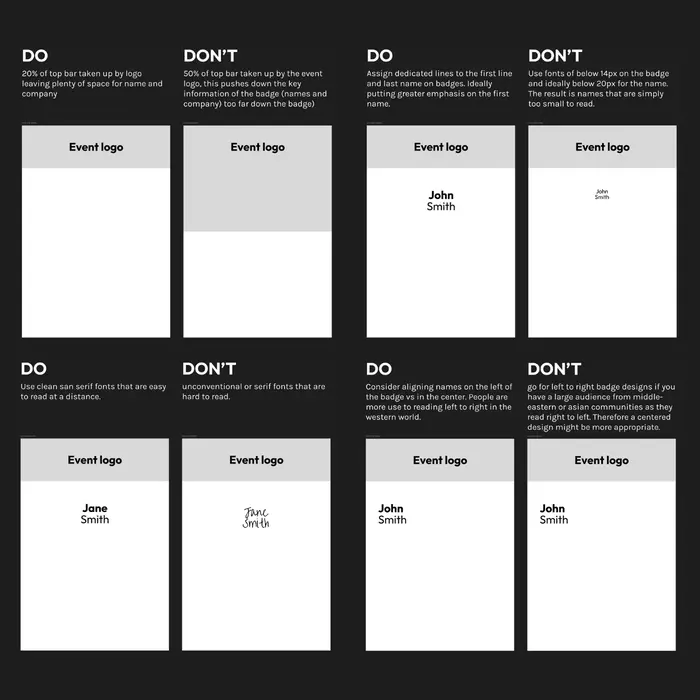
Ensuring that names are prominently displayed in large, readable fonts is crucial for facilitating networking.
“Mistakes I often see are organizers adding too much information to a badge,” said Rosanski. “Or where they don’t designate enough space for the data needed on the badge itself. We’ve also seen issues where the QR code wasn’t tested on sample badges that were printed with the onsite printers. This is a big deal and is sadly often overlooked!”
Another mistake is using low-quality materials that can lead to badge flipping or damage, causing frustration among attendees. Opting for durable, high-quality materials and double-sided printing can mitigate these issues. For Rosanski he believes this an important point as first-time organizers often opt for cheaper material for their badges, which is a false economy.
Neglecting accessibility considerations, such as font size, color contrast, and attachment options, can exclude individuals with disabilities. Implementing inclusive design principles ensures that badges are usable by all attendees.
“What gets in the way of good badge design? Oversized logos, tiny names, and single-clip lanyards,” says Raasted. “These are small mistakes that have big consequences.”
“It’s about scale. You need to print 10,000 badges efficiently, but don’t lose the human touch.” – Tim Groot
Andy Barr warns against overcomplicating tech. “Tech should enhance, not hinder. If your QR code leads nowhere or your app crashes, you've created friction, not flow.”
Tim Groot adds that scalability must not come at the cost of human connection. “You need to print 10,000 badges efficiently, but don’t lose the human touch.”
8: Are badgeless events the future? Or are smarter badges the answer?
“There have been attempts to go badgeless, but they create significant data gaps.” – Emily Miller
While digital alternatives to physical badges are emerging, a hybrid approach is gaining traction. Physical badges equipped with smart technology, such as NFC or RFID, can enhance functionality without sacrificing the tangible benefits of traditional badges.
“Any type of ‘smart badge’ will be the future,” explained Rosanski. “Adding a smart tag of some sort to an existing badge is the key. They give so much value to participants and organizers, plus the price will go down over time. I can see a future where people won’t go to a premium, paid-for, event unless they get one of these types of badges.”
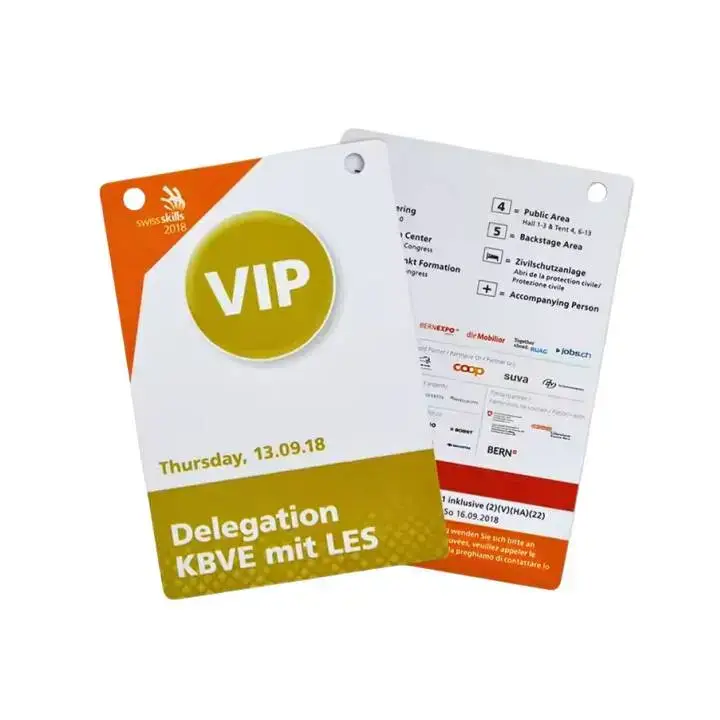
For example, integrating digital badges or Proof of Attendance Protocols (POAPs) allows attendees to collect verifiable digital tokens representing their participation. These tokens can be used for networking, accessing exclusive content, or as digital memorabilia. This blend of physical and digital elements caters to diverse attendees.
E-wallets, like Apple Wallet and Google Wallet are something most of us have today on our phones. “When you’re near a Starbucks and you have its loyalty card in your e-wallet, it’ll pop up and send you a notification that a store is nearby,” explained Smart. “This same technology can be leveraged for badges at specific shows in the B2C space. You can use it to scan your B2C event participants at registration and then they don’t need a badge for the show.”
Industry insiders remain cautious about going fully digital. “There have been attempts to go badgeless,” says Emily Miller, “but they create significant data gaps.”
The near future lies in hybrid innovation. Think lightweight wearables, interactive e-ink, or peer-to-peer taps of Smart Badges that sync with your event app. Tim Groot also admits he was initially skeptical of smart badge hardware - until he tried it. “It made connecting frictionless. I met more people. It just worked.”
Conclusion: Your badge strategy is your event’s brand
A badge is often the first branded item an attendee interacts with and the last thing they take home. It’s a name tag, a networking tool, a security measure, and a data point - all rolled into one.
“Everything is a designable surface,” says Raasted. “Badges included.”
Treating badge strategy as an afterthought is a missed opportunity. With intentional design, smart use of technology, and attention to inclusivity, a badge can elevate the attendee experience, support event objectives, and leave a lasting impression.
As you plan your next event, don’t just print a badge. Design an experience. Here's to the future of the event badge.
Bonus resources
Watch our on-demand webinar - The Future of Event Badges: Innovations, Sustainability, and User Experience



